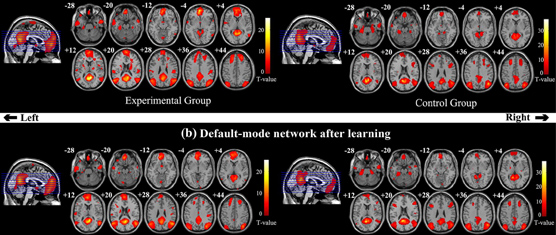
Abstract
Numerous studies provide evidences that motor skill learning changes the activity of some brain regions during task as well as some resting networks during rest. However, it is still unclear how motor learning affects the resting-state default-mode network (DMN). Using functional magnetic resonance imaging, this study investigated the alteration of the DMN after motor skill learning with mental imagery practice. Fourteen participants in the experimental group learned to imagine a sequential finger movement over a two-week period while twelve control participants did not undergo motor imagery learning. For the experimental group, interregional connectivity, estimated by the graph theory method, between the medial temporal lobe, lateral temporal, and lateral parietal cortex within the DMN was increased after learning, whereas activity of the DMN network, estimated by the independent component analysis method, remained stable. Moreover, the experimental group showed significant improvement in motor performance after learning and a negative correlation between the alteration of the execution rate and changes in activity in the lateral parietal cortex. These results indicate that the DMN could be sculpted by motor learning in a manner of altering interregional connectivity and may imply that the DMN plays a role in improving behavioral performance.

